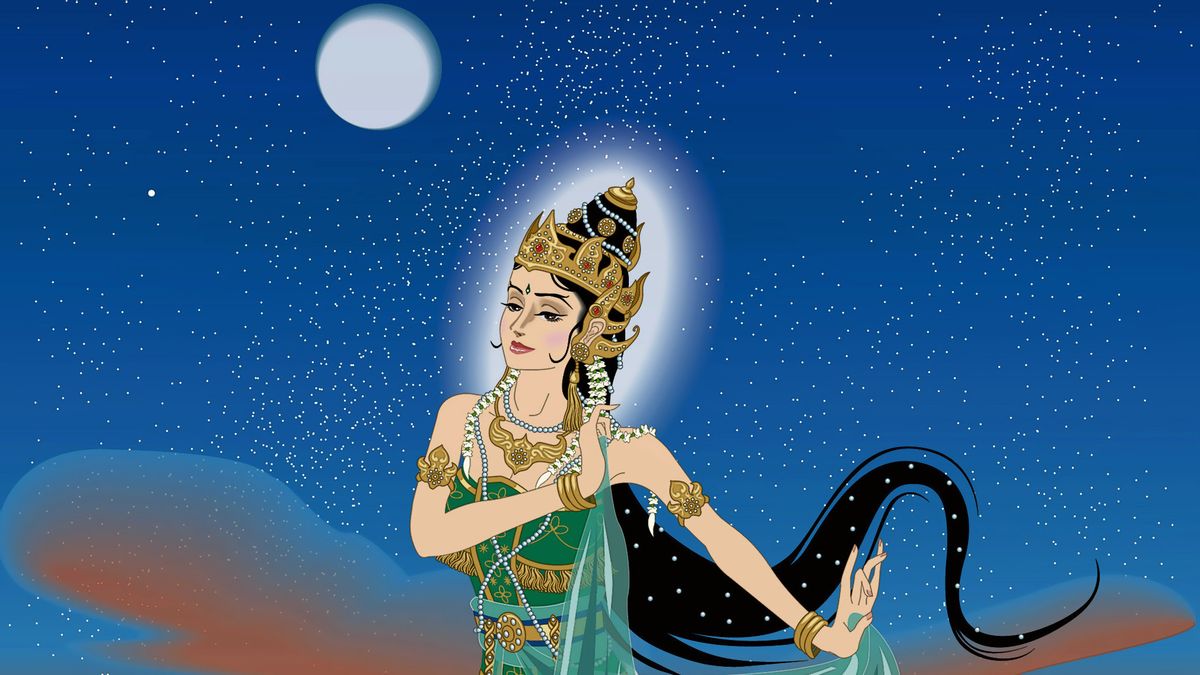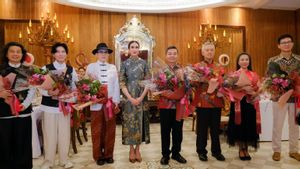JAKARTA - Nyi Roro Kidul is an ideal expression of portraying a mighty woman. Nyi Roro Kidul is the Queen of the South Coast. Nyi Roro Kidul is also a savior who protects the existence of the Mataram Kingdom. Many versions describe the figure of Nyi Roro Kidul. It is a real thing that is 'hidden' or a supernatural thing that is made as if it were real. What is clear, Nyi Roro Kidul is more than a konco wingking alias a sleeping companion, as is the ancient description.
The presence of Nyi Roro Kidul has always been a puzzle. Regarding origins, for example. There are many versions of where Nyi Roro Kidul came from.
The most popular is about Nyi Roro Kidul as the daughter of the king of Kediri, Jayabaya. Another version believes that Nyi Roro Kidul is a descendant of King Airlangga from Kahuripan. Later, Nyi Roro Kidul was also called the daughter of King Pajajaran.
We can describe various literacies that strengthen the last version. Merle Calvin Ricklefs, in the book History of Modern Indonesia 1200-2008 (2008) wrote the real name Nyi Roro Kidul, the daughter of Raja Pajajaran, as Dewi Retno Suwodo.
"According to the Mataram tradition, Ratu Kidul was a daughter of Pajajaran who was expelled from the palace for refusing to marry according to her father's wishes. King Pajajaran cursed her daughter: she was made queen of spirits with her palace under the waters of the Indian Ocean, and would become an ordinary woman again in doomsday, "said Ricklefs.
Not only that. Ratu Kidul is also predicted to have no husband. Even if they are married, the men who marry them will come from a limited circle, namely the Islamic kings of Java. This prophecy links the name Ratu Kidul as the patron goddess of the Islamic Mataram Kingdom as well as the magical wife of the Javanese kings.
"In Babab Tanah Jawi, Penembahan Senopati (1584-1601) and Sultan Agung (1613-1646) are told that they departed from Parangtritis to meet the queen in an underwater palace, which was only inhabited by spirits and had sex with her. Intimate and special relationship between the founding king of Mataram and the Queen brought the kingdom to its peak in the early 17th century during the reign of Senopati's grandson, Sultan Agung, "said Peter Carey and Vincent Houben in the book Perempuan-Perempuan Perkasa di Jawa XVIII-XIX Century (2016).
Nyi Roro Kidul, the real occult
Long story short, the Javanese people at that time believed that Ratu Kidul was the incarnation of two conflicting figures. Batari Durga who is known as the goddess of destruction and chaos, as well as Dewi Uma who is the goddess of protection and prosperity. It was for his supernatural powers that the kings of Java then established a relationship with Ratu Kidul to ensure the safety of the country he led.
This means that if a Javanese king does not want to lose his dignity, he must immediately subdue Ratu Kidul so that he does not become Batari Durga. The trick, of course, is to marry the queen. Written by Soemardaid Moertono in the book State and Power in Java in the XVI-XIX Century (2017), Nyi Roro Kidul was first married to Panembahan Senopati and then with all the kings of Mataram. All that was done as well as possible for the security of the kingdom.
“… Because in times of danger he will come to help raka with his innumerable (invaluable) army of jinns . But, sometimes Nyai's unfathomable heart still wants to take the lives of many of her people in various kinds of epidemics, "said the historian who is familiarly called Mas Moer.
The harbor's annual efforts were carried out. The event was a ceremony to send a gift to the Queen of South on a raft that was allowed to be carried by the waves towards the Indian Ocean. The ceremony was carried out by order of the King of Yogyakarta. Through this tradition, people understand the relationship between the rulers in the human world and Nyai Roro Kidul as one of the rulers of the supernatural world.
The labuhan offering usually consists of an awisan-dalem damaged machete cloth with green kemben (cangkring cloth, sumekan gaadung) and a green-and-white batik pattern called gadung mlati, which is taken from the name of the spirit protector Parangtritis (Nyai Gadung Melati). Green is an important element in offerings because it is believed to be the Queen of South's favorite color. All these offerings are usually prepared by the Yogyakarta Palace.
Uniquely, the gadung mlati batik is often used by dancers in the Keraton Surakarta and the Yogyakarta Palace when playing the sacred dance of Bedoyo Ketawang (Kesunanan) or Bedoyo Semang (Sultanate). The dance is played to invite the spirit of Ratu Kidul to come and have intercourse with the king.
The real is unseen
Many believe in Nyi Roro Kidul's existence. However, there are also many people who doubt the influence of the rulers of the south coast. Some of those who are agitated are the well-known Indonesian writers, Pramoedya Ananta Toer. In his speech at the acceptance of the 1988 Ramon Magsaysay award, Pram called the Queen of South story just a myth.
Through a written speech entitled Literature, Censorship and the State: How Far is the Danger of Reading? Pram tries to explain how the Mataram Palace poet created the myth of Nyi Roro Kidul as compensation for Sultan Agung's defeat when he attacked Batavia twice (1628 and 1629) as well as Sultan Agung's failure to control the trade routes on the North Coast of Java.
"To cover up the loss, the Javanese poet created the Goddess of the Sea Nyi Roro Kidul as a blanket, that Mataram still controlled the sea, here the South Sea (Indian Ocean). This myth gave birth to other mythical children: that every Mataram king has a goddess, "said Pram.
According to Pram, departing from the myth of Nyi Roro Kidul, other taboo myths emerged, such as the prohibition of wearing green clothes on the southern coast. In fact, it was only a form of hatred by the poets against the Company. Green, Pram said, represented the color of the Dutch soldiers' clothes.
However, historian Ong Hok Ham considers that this is still a reasonable level. Ong said, the myth of Nyi Roro Kidul is a positive myth. The creation of myths and their users is clear to perpetuate Mataram's power. In fact, Ong added that it is a common thing, both in the past and in the present.
“The myth of Nyi Roro Kidul actually strengthens the king's legitimacy. This is in contrast to the rich people associated with Nyi Blorong. The latter is negative, while the first, namely the relationship between the King of Mataram and Nyai Roro Kidul, is positive. For the sake of being with other spirits who protect the King of Mataram, namely Sunan Lawu on Mount Lawu, "wrote Ong Hok Ham in the book From priyayi to Nyi Blorong (2002).
The English, Chinese, Japanese, Arabic, and French versions are automatically generated by the AI. So there may still be inaccuracies in translating, please always see Indonesian as our main language. (system supported by DigitalSiber.id)













